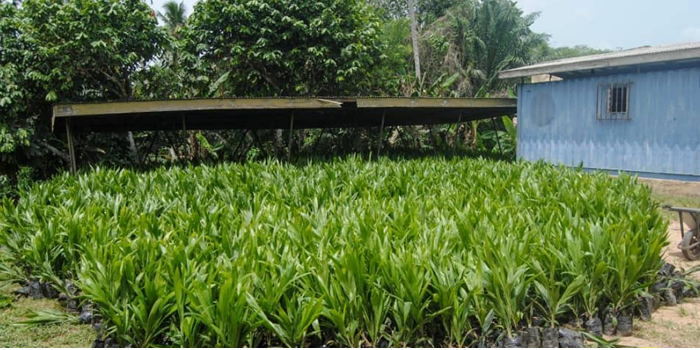

Economy of the District
Farming is the predominant economic activity in the district. The cultivable land area is estimated to be 89,000 hectares out of which about 43,000 hectares is under cultivation. Per the ministry of food and agriculture (MOFA), cocoa is one of the major crops whose cultivation could be intensified as stated in their research. Ajumako- Enyan -Essiam district, until the 1983 bush fires that swept through most of the country was a cocoa district. However due to our fertile lands and the determination of our farmers, all the cocoa farms that were destroyed have been re-cultivated and the district year after year has seen the cultivation of new cocoa farms.
The district has twelve (12) cocoa sheds with nine (9) being functional. We have three (3) nurseries and two (2) Cocoa and Extension Division Officers. In 2015 one of the offices was renovated. Recently, through the efforts of the District Chief Executive, the District has once again received approval from the Ghana Cocoa Board to be made a Cocoa District.
Occupation
Table 12 gives information on the employed population 15 years and older by occupation and sex. Per the table, skilled agriculture, forestry and fishery employ the largest (58.5%) of the employed population. This is followed by service and sales workers which employs 15.5 percent. Craft and related trades also make up 12.4 percent. Managers, professionals, and technicians together employ 6.5 percent.
The proportion of males in skilled agriculture, forestry and fishery (62.4%) is higher than the proportion of females in the same category (55.5%). However, for the Service and Sales workers group, the proportion of females is 22.5 percent which far exceeds that of the males (6.1%). This may be due to the low educational levels of females that make them go into petty trading, hairdressing, tailoring and other service occupations. Clerical support workers employ the least proportion of males (0.9%) whiles Plant and machinery operators and assemblers employ the least of the females (0.2%).
Table 12: Employed population 15 years and older by occupation and sex
Source: Ghana Statistical Service, 2010 Population and Housing Census.
Table 13: Employed population 15 years and older by industry and sex
Employment status
Figure 10 shows the population of persons 15 years and older by their employment status and sex. According to the table 71.0 percent of the employed are self-employed (without employees) and this forms the highest proportion of the employed. Also, 8.8 percent are employees, 14.0 percent are “contributing family workers,” while 1.2 percent are casual workers and 1.5 percent are apprentices. The proportion for self-employed (with employees) is very low (3.2%) compared to the self-employed (without employees), 71.0%.
The proportion that is self-employed (without employees) for the females (74.8%) far outweigh that of the males (66.0%). The proportion of females who are “contributing family workers” (15.0%) also exceeds that of males (12.7%). On the contrary, while 13.8 percent of the employed males are employees, only 5.1 percent of the employed females are employees. This may be attributed to the low education of the females which does not enable them to enter into formal sectors, but rather take to petty trading as self-employers due to insufficient capital outlay.
Figure 11: Population of persons 15 years and older by their employment status and sex
Source: Ghana Statistical Service, 2010 Population and Housing Census.
Employment
Sector Figure 11 provides information on employed population 15 years and older by employment sector. Whiles the Public (Government sector) employs only 4.5 percent of the employed; the Private Informal employs 92.8 percent. The private formal also employs 2.4 percent.
Appendix table A4.2 indicates that there is a higher proportion of employed males (6.9%) than that of the females (2.7%) in the public sector. Both proportions (for male and female in the public sector) are higher than those in the private formal sector (male-3.6%, female-1.5%). The table also shows that the proportion of females employed in the private informal sector exceeds (95.5%) that of the males (89.1%). On the whole, there are more males in the formal sector and more females in the informal sector. This may be explained by the lower educational level of females than males. This situation however has implications on the accessibility to social security, banking, and credit facilities by women.
Figure 12: employed population 15 years and older by employment sector
Source: Ghana Statistical Service, 2010 Population and Housing Census.
Table 14: Tourism Sites
Food Security
Food security is a situation where all people, always have physical, social and economic access to sufficient, safe and nutritious food that meets their dietary needs and food preferences for an active and healthy life. The element of food safety will be a concern in Ajumako-Enyan-Essaim District Assembly’s pursuit of food security. Although the objective of attaining food security is a national affair, it is the poor that are most vulnerable to food insecurity and that people of Ajumako-Enyan-Essaim are no exception. The low production of the staple crops such as rice, maize and cassava in the district is a threat to food security. The Department of Food and Agriculture aims at helping farmers to increase their production of these staple crops through the supply of improved planting materials, fertilizers and appropriate technologies to enhance productivity in the District. However, the staple crops produce are available on market but at a high cost price.
Nutrition Nutrition is simply the process by which one takes in and utilizes nutrients. It plays pivoted role in all aspect of health care including;
? Dieting management of chronic diseases like diabetes and hypertension
? Health education on disease prevention and micro nutrient deficiencies.
? School health services
? Growth monitoring and promotion
? Infant and young Child feeding.
All the above listed services are being rendered in the District. We usually get opportunity to do integrate monitoring and supervision with units in the district to all the health facilities in the district on the ticket of MCHPS.
The challenges we do encounter are on improving infant and young child feeding. This is because Mothers and caregivers tend to stop exclusive breastfeeding because of societal and commercial pressure. Although there are tools to meet this challenge like the Global strategy for IYCF which include international Code of marketing of Breast milk substitute and baby friendly initiative but it effectiveness is not all that encouraging thereby resulting in increased number of malnutrition cases.
Also, expanding on existing iodine and Vitamin A programmes to ensure it sustainability will be a plus to the district. Vitamin A capsule supplementation is in progress but iodine testing in salt exercise is no more and can be activated again to help in the development of our children.
Table 15: Decentralised Departments/Agencies/Service in the District
DPCU Construct, 2017
Date Created : 8/29/2024 12:00:00 AM










 facebook
facebook
 twitter
twitter
 Youtube
Youtube
 +233 593 831 280
+233 593 831 280 0800 430 430
0800 430 430 GPS: GE-231-4383
GPS: GE-231-4383 info@ghanadistricts.com
info@ghanadistricts.com Box GP1044, Accra, Ghana
Box GP1044, Accra, Ghana